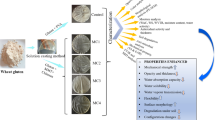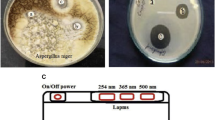Abstract
A novel wheat gluten (WG) film was developed by adding vanillin, salicylic acid, and montmorillonite cloisite 15A (MMT). Some physico-mechanical properties, including thickness, tensile strength (TS), elongation at break (E), yellowness index (YI), whiteness index (WI), and water solubility (SWF) of the film were investigated using response surface methodology. Results revealed that maximum tensile strength occurred at the highest level of MMT and salicylic acid, and that the effect of MMT on elongation at break was considerable. The YI and WI of the composite films increased respectively, while the WI value and increment of MMT reduced. Moreover, the water solubility was raised with an increasing amount of MMT, vanillin, and salicylic content in the films. The optimum level of the variables obtained by the software was 0.92% vanillin, 0.94% salicylic acid, and 1.92% MMT (% w/w). The intensity and shifting of some absorption peaks in the FTIR spectra pattern confirmed the interaction of functional groups of additive and gluten chain. SEM images revealed an even distribution of the particles with no evidence of particle agglomeration in WG/vanillin/salicylic acid/MMT. Inhibition zone around the nanocomposite films against Aspergillus niger and Alternaria alternate strains indicated antifungal activity of WG nanocomposite films, which was more considerably observed for Aspergillus niger.






Similar content being viewed by others
Abbreviations
- MMT:
-
Montmorillonite
- TS:
-
Tensile strength
- E:
-
Elongation at break
- YI:
-
Yellowness index
- WI:
-
Whiteness index
- SWF:
-
Water solubility film
- WG:
-
Wheat gluten
- RSM:
-
Response surface method
- CCD:
-
Central composite design
- FTIR:
-
Fourier transform infrared spectroscopy
- SEM:
-
Scanning electron microscope
- PDA:
-
Potato dextrose agar
- ANOVA:
-
Analysis of variance
- CV:
-
Coefficient of variation
References
Ağçeli, G. K., & Cihangir, N. (2020). Synthesis, characterization and antimicrobial performance of novel nanostructured biopolymer film based on levan/clay/LL-37 antimicrobial peptide. Biocatalysis and Agricultural Biotechnology, 23, 101421.
Alboofetileh, M., Rezaei, M., Hosseini, H., & Abdollahi, M. (2013). Effect of montmorillonite clay and biopolymer concentration on the physical and mechanical properties of alginate nanocomposite films. Journal of Food Engineering, 117(1), 26–33.
Aydogdu, A., Radke, C. J., Bezci, S., & Kirtil, E. (2020). Characterization of curcumin incorporated guar gum/orange oil antimicrobial emulsion films. International Journal of Biological Macromolecules, 148, 110–120.
Bagheri, V., Ghanbarzadeh, B., Ayaseh, A., Ostadrahimi, A., Ehsani, A., Alizadeh-Sani, M., & Adun, P. A. (2019). The optimization of physico-mechanical properties of bionanocomposite films based on gluten/carboxymethyl cellulose/cellulose nanofiber using response surface methodology. Polymer Testing, 78, 105989.
Casariego, A., Souza, B. W. S., Cerqueira, M. A., Teixeira, J. A., Cruz, L., Díaz, R., & Vicente, A. A. (2009). Chitosan/clay films’ properties as affected by biopolymer and clay micro/nanoparticles’ concentrations. Food Hydrocolloids, 23(7), 1895–1902.
Costa, L. A.d., Diogenes, I. C. N., Oliveira, M.d. A., Ribeiro, S. F., Furtado, R. F., Bastos, M.d. S. R., Silva, M. A. S., & Benevides, S. D. (2020). Smart film of jackfruit seed starch as a potential indicator of fish freshness. Food Science and Technology.
Davachi, S. M., & Shekarabi, A. S. (2018). Preparation and characterization of antibacterial, eco-friendly edible nanocomposite films containing Salvia macrosiphon and nanoclay. International Journal of Biological Macromolecules, 113, 66–72.
Erkmen, O., & Onder, B. A. (2018). General characteristics of edible films. Journal of Food Biotechnology Research, 2, 1–4.
Fache, M., Boutevin, B., & Caillol, S. (2015). Vanillin, a key-intermediate of biobased polymers. European Polymer Journal, 68, 488–502.
Fakhouri, F. M., Martelli, S. M., Caon, T., Velasco, J. I., & Mei, L. H. I. (2015). Edible films and coatings based on starch/gelatin: Film properties and effect of coatings on quality of refrigerated Red Crimson grapes. Postharvest Biology and Technology, 109, 57–64.
Fathi Achachlouei, B., & Zahedi, Y. (2018). Fabrication and characterization of CMC-based nanocomposites reinforced with sodium montmorillonite and TiO2 nanomaterials. Carbohydrate Polymers, 199, 415–425.
Fatyeyeva, K., Chappey, C., Marais, S. (2017). Biopolymer/clay nanocomposites as the high barrier packaging material: recent advances. 425-463.
Guimarães, A., Ramos, Ó., Cerqueira, M., Venâncio, A., & Abrunhosa, L. (2020). Active whey protein edible films and coatings incorporating Lactobacillus buchneri for Penicillium nordicum control in cheese. Food and Bioprocess Technology, 13(6), 1074–1086.
Gutiérrez, T. J., & Alvarez, V. A. (2018). Bionanocomposite films developed from corn starch and natural and modified nano-clays with or without added blueberry extract. Food Hydrocolloids, 77, 407–420.
Han, J. H. (2014). Chapter 9 - Edible films and coatings: a review, innovations in food packaging (Second Edition) (pp. 213–255). San Diego: Academic Press.
Henrik Ullsten, N., Gällstedt, M., Johansson, E., Gräslund, A., & Hedenqvist, M. S. (2006). Enlarged processing window of plasticized wheat gluten using salicylic acid. Biomacromolecules, 7(3), 771–776.
Hernández-Muñoz, P., Villalobos, R., & Chiralt, A. (2004a). Effect of cross-linking using aldehydes on properties of glutenin-rich films. Food Hydrocolloids, 18(3), 403–411.
Hernández-Muñoz, P., Villalobos, R., & Chiralt, A. (2004b). Effect of thermal treatments on functional properties of edible films made from wheat gluten fractions. Food Hydrocolloids, 18(4), 647–654.
Huiyu Bai, R. K., Cheng, Y., Liu, X., & Zhang, L. (2010). Effect of salicylic acid on the mechanical properties and water resistance of soy protein isolate films. Polymers & Polymer Composites, 18.
Koehler, P., Wieser, H., Konitzer, K. (2014). Gluten—the precipitating factor. 97-148.
Kuktaite, R., Türe, H., Hedenqvist, M. S., Gällstedt, M., & Plivelic, T. S. (2014). Gluten biopolymer and nanoclay-derived structures in wheat gluten–urea–clay composites: Relation to barrier and mechanical properties. ACS Sustainable Chemistry & Engineering, 2(6), 1439–1445.
Lim, G.-O., Jang, S.-A., & Song, K. B. (2010). Physical and antimicrobial properties of Gelidium corneum/nano-clay composite film containing grapefruit seed extract or thymol. Journal of Food Engineering, 98(4), 415–420.
Marcet, I., Álvarez, C., Paredes, B., Rendueles, M., & Díaz, M. (2017). Transparent and edible films from ultrasound-treated egg yolk granules. Food and Bioprocess Technology, 11, 735–747.
McGlashan, S. A., & Halley, P. J. (2003). Preparation and characterisation of biodegradable starch-based nanocomposite materials. Polymer International, 52(11), 1767–1773.
Micard, V., Belamri, R., Morel, M.-H., & Guilbert, S. (2000). Properties of chemically and physically treated wheat gluten films. Journal of Agricultural and Food Chemistry, 48(7), 2948–2953.
Molinaro, S., Cruz Romero, M., Boaro, M., Sensidoni, A., Lagazio, C., Morris, M., & Kerry, J. (2013). Effect of nanoclay-type and PLA optical purity on the characteristics of PLA-based nanocomposite films. Journal of Food Engineering, 117(1), 113–123.
Montgomery, D.-C. (2012). Design-and-analysis of experiments-Wiley. Eighth edition, 757.
Pandey, J.K., Singh, R.P. (2005). Green nanocomposites from renewable resources: Effect of plasticizer on the structure and material properties of clay-filled starch. Starch 57, 8-15.
Pandey, N., Joshi, S. K., Singh, C. P., Kumar, S., Rajput, S., & Khandal, R. K. (2013). Enhancing shelf life of litchi (Litchi chinensis) fruit through integrated approach of surface coating and gamma irradiation. Radiation Physics and Chemistry, 85, 197–203.
Peng, H., Xiong, H., Li, J., Xie, M., Liu, Y., Bai, C., & Chen, L. (2010). Vanillin cross-linked chitosan microspheres for controlled release of resveratrol. Food Chemistry, 121(1), 23–28.
Pizzolitto, R. P., Barberis, C. L., Dambolena, J. S., Herrera, J. M., Zunino, M. P., Magnoli, C. E., Rubinstein, H. R., Zygadlo, J. A., & Dalcero, A. M. (2015). Inhibitory effect of natural phenolic compounds on Aspergillus parasiticus growth. Journal of Chemistry, 2015, 1–7.
Rossi-Márquez, G., Han, J. H., García-Almendárez, B., Castaño-Tostado, E., & Regalado-González, C. (2009). Effect of temperature, pH and film thickness on nisin release from antimicrobial whey protein isolate edible films. Journal of the Science of Food and Agriculture, 89(14), 2492–2497.
Rostamzad, H., Paighambari, S. Y., Shabanpour, B., Ojagh, S. M., & Mousavi, S. M. (2016). Improvement of fish protein film with nanoclay and transglutaminase for food packaging. Food Packaging and Shelf Life, 7, 1–7.
Saberi, B., Thakur, R., Vuong, Q. V., Chockchaisawasdee, S., Golding, J. B., Scarlett, C. J., & Stathopoulos, C. E. (2016). Optimization of physical and optical properties of biodegradable edible films based on pea starch and guar gum. Industrial Crops and Products, 86, 342–352.
Sangsuwan, J., Rattanapanone, N., & Rachtanapun, P. (2008). Effects of vanillin and plasticizer on properties of chitosan-methyl cellulose based film. Journal of Applied Polymer Science, 109(6), 3540–3545.
Silverstein, R. M., & Bassler, G. C. (1962). Spectrometric identification of organic compounds. Journal of Chemical Education, 39(11), 546.
Singh, N., Georget, D. M. R., Belton, P. S., & Barker, S. A. (2010). Physical properties of zein films containing salicylic acid and acetyl salicylic acid. Journal of Cereal Science, 52, 282–287.
Sothornvit, R., Rhim, J.-W., & Hong, S.-I. (2009). Effect of nano-clay type on the physical and antimicrobial properties of whey protein isolate/clay composite films. Journal of Food Engineering, 91(3), 468–473.
Sung-Woo Cho, T.O.J.B., Helena Halonen, Mikael Gällstedt, A.S.H. (2012). Wheat gluten-laminated paperboard with improved moisture barrier properties: A new concept using a plasticizer (glycerol) containing a hydrophobic component (oleic acid). International Journal of Polymer Science, 1-9.
Tanada-Palmu, P. S., & Grosso, C. R. F. (2005). Effect of edible wheat gluten-based films and coatings on refrigerated strawberry (Fragaria ananassa) quality. Postharvest Biology and Technology, 36(2), 199–208.
Tharanathan, R. N. (2003). Biodegradable films and composite coatings: past, present and future. Trends in Food Science & Technology, 14(3), 71–78.
Trinetta, V. (2016). Edible packaging, reference module in food science. Elsevier.
Uddin, F. (2013). Studies in finishing effects of clay mineral in polymers and synthetic fibers. Advances in Materials Science and Engineering, 2013, 1–13.
Verbeek, C. J. R., & van den Berg, L. E. (2010). Extrusion processing and properties of protein-based thermoplastics. Macromolecular Materials and Engineering, 295(1), 10–21.
Wittaya, T. (2012). Protein-based edible films: Characteristics and improvement of properties.
Wolf, F. T., & Wolf, F. A. (2018). Chemical agents for the control of molds on meats. Mycologia, 42, 344–366.
Xavier, J. R., Babusha, S. T., George, J., & Ramana, K. V. (2015). Material properties and antimicrobial activity of polyhydroxybutyrate (PHB) films incorporated with vanillin. Applied Biochemistry and Biotechnology, 176(5), 1498–1510.
Zheng, T., Yu, X., & Pilla, S. (2017). Mechanical and moisture sensitivity of fully bio-based dialdehyde carboxymethyl cellulose cross-linked soy protein isolate films. Carbohydrate Polymers, 157, 1333–1340.
Zheng, K., Xiao, S., Li, W., Wang, W., Chen, H., Yang, F., & Qin, C. (2019). Chitosan-acorn starch-eugenol edible film: Physico-chemical, barrier, antimicrobial, antioxidant and structural properties. International Journal of Biological Macromolecules, 135, 344–352.
Zhu, H., Zhang, Y., Tian, J., & Chu, Z. (2018). Effect of a new shell material—jackfruit seed starch on novel flavor microcapsules containing vanilla oil. Industrial Crops and Products, 112, 47–52.
Zink, J., Wyrobnik, T., Prinz, T., Schmid, M. (2016). Physical, Chemical and biochemical modifications of protein-based films and coatings: An extensive review. International Journal of Molecular Sciences 17.
Author information
Authors and Affiliations
Corresponding author
Ethics declarations
Competing Interest
The authors declare that they have no competing interests.
Additional information
Publisher’s Note
Springer Nature remains neutral with regard to jurisdictional claims in published maps and institutional affiliations.
Rights and permissions
About this article
Cite this article
Khashayary, S., Aarabi, A. Evaluation of Physico-mechanical and Antifungal Properties Of Gluten-based Film Incorporated with Vanillin, Salicylic Acid, and Montmorillonite (Cloisite 15A). Food Bioprocess Technol 14, 665–678 (2021). https://doi.org/10.1007/s11947-021-02598-y
Received:
Accepted:
Published:
Issue Date:
DOI: https://doi.org/10.1007/s11947-021-02598-y




